While not quite as major of detail to consider as factors such as tonewood or pickup, the headstock of the guitar is something you’ll want to consider. Although the main function of the headstock is fairly obvious, it affects the sound and playability of the guitar in numerous other ways, as well as provides an aesthetic element to the guitar itself.
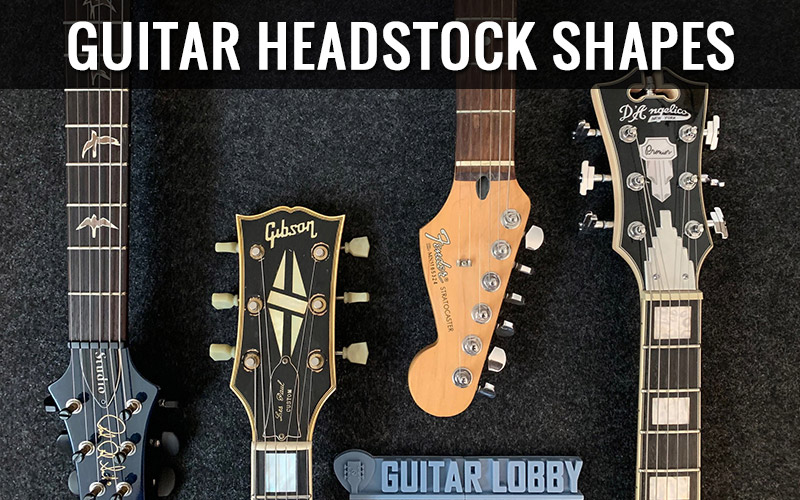
Brands such as Gibson, Fender, and PRS have very distinctive headstock shapes. For example, there is an interesting story behind the Fender Stratocaster’s headstock shape that not too many people are familiar with. If there are any stringed instrument aficionados reading this, they will probably find the shape of Strat’s headstock similar to the shape of the headstock found on the tamburitza, which is a stringed instrument that is played in Croatia, parts of Serbia, as well as throughout most of the Balkan region.
Supposedly, Leo Fender came into contact with the instrument through his college roommate who was from Croatia, and he liked the headstock so much that he decided to create his own take on the existing shape. In this guide, you will learn everything there is to know about different guitar shapes, designs, variations, and sizes, as well as how they affect not just the looks, but also the tuning and playability of your guitar. More on that in the paragraphs below.
Why Guitar Headstock Shape Matters:
Guitar Headstock Structure Types Explained
The more you know about guitars, the more complicated it becomes to choose the right one, since you know how each of the components affects sound, tuning, and playability. On top of that, nearly every guitar part has several different designs you can choose from, making your selection even more difficult. Headstocks are no exception since there are three main types:
Let’s take a closer look at each of these headstocks, as well as their major pros and cons
1. Straight (Flat) Headstock

This type of headstock design was popularized by Leo Fender himself back in the 1950s. The goal was to come up with a headstock that would be rigid enough, cheap to produce, and that wouldn’t waste too much wood in the process. The resulting design was the straight headstock, which Fender used on his Telecaster guitar. It would go on to be used for the construction of the Stratocaster. Unlike the headstock which involves an angle, straight headstock has a very thin profile, which means that you really only need lumber that is about 2 inches thick or even less. And since the neck and the headstock are just a single piece of wood, this design is very strong. Even if you are using laminate wood to build the neck and the headstock, you will still end up with very rigid construction.
The straight headstock type is very cheap to produce since less work is needed. Another reason why it’s cheap, apart from simplicity, is the fact that there isn’t a lot of waste, so you can use thinner pieces of lumber or laminate. A lot of budget brands, such as Squier, opt from straight headstocks since they keep the production cost down. But, where there are pros, there are also cons, and straight headstocks have a few of the latter.
Technically, there is only one real issue here, its simple design, which requires complicated solutions. More specifically, we are talking about the angle between the nut and the strings that are further away from it. On Fender guitars, for example, the longest string would be the high E string, whereas, on other guitars, we would talk about the string that reaches further up the headstock. Why is this angle so important? Well, the issue doesn’t have anything to do with looks or the fact that the string angles are inconsistent, since that doesn’t affect the sound, but it can affect playability. You see, the shallower the angle of the string, the more likely the string is to slip out of its groove if you are bending it really hard since there isn’t enough pressure on the nut. Also, it may lead to string buzz.
Several solutions have been designed in order to remedy this issue. The most common option you will find on affordable guitars is ‘string trees’, which are basically small pieces of metal that are drilled into the headstock, and which pull down on the strings in order to create a sharper angle, as well as more tension. Then there is the ‘string retainer bar’ which does more of the same, but instead of holding the problematic individual stings in place, it pulls down on all of the strings together. String retainer bars are usually used with Floyd or locking nuts.
Finally, there is the option that features staggered tuners, which are more complex and can usually be found on expensive Fender Stratocasters. Staggered tuners are essential tuners which have tuning pegs of different height. The further down the headstock the peg is, the shorter it will be. This makes up for the shallow break angle, and also does away with string trees, which are not needed in this case.
2. Angled (Tilted-Back) Headstock

The second type of headstock, as you can tell by its name, is the angled or tilted-back headstock. Just like its straight counterpart, the angled headstock is a one-piece design. But, given that the angle between the headstock and the neck is much sharper, this particular design is more expensive to produce, since it requires more wood, and as we know, the larger the piece of wood, the more expensive it is. Angled headstocks can usually be seen on mid to high-end guitars, such as Gibsons, even though Gibson has caught some flak for it.
The biggest advantage of angled headstocks is that they eliminate the flaws that are inherent to the flat headstock design. Because the angle is sharp enough, there is sufficient tension on the strings which have no way of slipping from the grooves of the nut. This means that complicated solutions, such as string trees, retainer bars, or staggered tuners, are needed. Also, the increased tension on the strings results in better sustain. For instance, Gibson Les Pauls are legendary for their sustain, especially when compared to Strats or Teles, and that’s partly because of the angle of the headstock.
On the other hand, many guitar aficionados say that angled headstocks, for all of their advantages, are structurally less sound than flat headstocks, even though they are both single-piece designs. Due to a larger angle, there is more tension on the headstock and the neck, which means that, at least in theory, this type of headstock is more prone to breaking. And there have been quite a few examples in practice that confirm this theory. For instance, Slash has broken the headstock of one of his Les Paul guitars on at least one occasion, while doing a ‘dive bomb’. The headstock broke off, and the neck hit Slash across the face, putting a huge hole in his upper lip. The reason behind this issue might be the shorter wood grain between the headstock and the neck, which makes this headstock easier to break.
Another disadvantage of the angled headstock is that they are more expensive to produce, and a lot more excess wood is created in the process, which is the polar opposite of the flat headstock. This is one of the reasons why Gibson Les Pauls are more expensive than Fender Stratocaster, even if you were to find comparable USA-made models. Finally, angled headstock requires more working hours and more craftsmanship, which also contributes to the higher price tag.
What Is a Volute?
One of the ways in which some manufacturers, such as Ibanez or Schecter, compensate for the lack of headstock strength on their high-end strength is by adding a ‘volute’ to the nut, which is basically a section where the wood is thicker. While having a volute does make the headstock stronger, it does make the production more expensive, since it requires more and working hours to produce.
3. Scarf Headstock

Although it technically belongs in the category of angled headstocks, the scarf headstock is somewhat of a mixture between the flat and angled headstock, and neither one at the same time, if that makes any sense. Both straight and angled headstocks are made using a single piece of lumber, whereas a scarf headstock is made from two pieces of wood. The scarf joint is created by cutting a flat piece of lumber at an angle, and the two pieces are glued back together, in one of two possible ways, so that the grain of the wood on the headstock runs in parallel with the face of the headstock. This can be done both with solid and laminated woods.
One of the advantages of having a scarf headstock is better string stability, as well as good tone and sustain. Despite it being angled, this type of headstock is pretty rigid, thanks to the way the grain runs along the length of the headstock. Another advantage is that it can be manufactured using thinner pieces of wood, which are cheaper, as in the case of straight headstocks. On top of that, there is very little material wasted this way. While that does drive the price down, keep in mind that sawing, then gluing back two pieces of wood requires more time and work. This puts scarf headstocks somewhere in the middle between straight and angled headstock in terms of price.
4. Headless Guitars
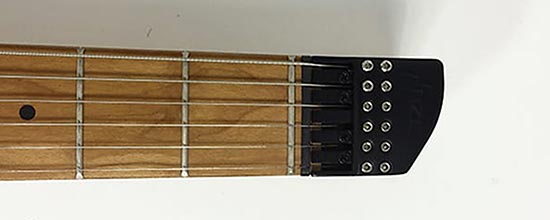
Mind you, not all guitar headstocks are built like this, and on top of that, not all guitars have headstocks. You have probably seen some “headless” guitars from brands like Steinberger, Strandberg, or Kiesel. Although these guitars don’t have headstocks, most of the parts you would find on traditional guitars can be found here. The only difference is that they are housed inside the body of headless guitars. This innovative approach actually has several things going for it. For starters, these guitars are much lighter, which does come in handy if you are playing long gigs. Also, the design allows for quicker string changes, and the guitar stays in tune for longer.
On the other hand, headless guitars are more expensive, and due to the lack of tuners, they cannot be tuned while you are playing the guitars, which limits your playing somewhat. Also, it may not be a big deal for most players, but you can’t put these guitars on a standard guitar hanger, since there is no headstock to support the rest of the instrument. Finally, most headless guitars have very unique body shapes and designs, so if you are in the market for a headless guitar that has a classic shape, you will have your work cut out for you.
10 Common Guitar Brands and Their Unique Headstock Shapes
We have already briefly mentioned some of the guitar brands and the types of headstocks that they use, but here, we will talk about 10 popular guitar brands, and let you know about the type of headstock that their guitars use. So, let’s begin.
1. Fender
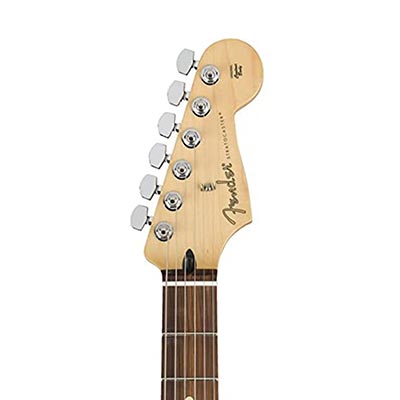
Fender uses straight/flat headstocks for their guitars, such as the Telecaster and the Stratocaster. What is interesting about the Stratocaster in particular, is that its signature headstock can be found in two different sizes, large and small, with the same design/shape. The original, smaller headstock, was in use before CBS bought Fender back in 1965. CBS introduced a larger headstock, and one of the reasons they did is because it allowed for a bigger Fender logo. Fender headstocks are notable for their use of string trees, as well as staggered tuners to compensate for the shallow break angle of the strings. Fenders feature a 6-in-line tuner layout.
2. Gibson
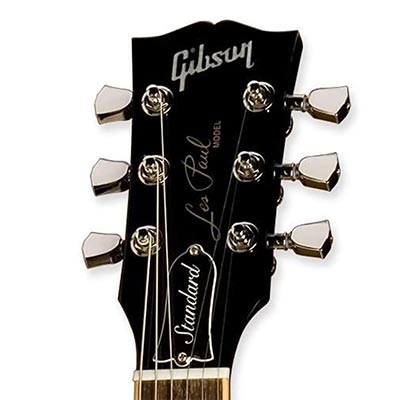
Gibson uses angle one-piece headstocks for most of the models in their product range, known as the “open book” headstock. The older ones have sort of become notorious due to numerous anecdotes about their headstocks breaking. Gibson has addressed these issues over the years by introducing numerous innovations to make their headstock better. For example, because the strings leave the nut at an angle (we are talking about the sideways angle, not the break angle), Gibson has experimented with numerous alloys to keep their strings from sticking. Angled headstocks can be found on all of their guitars, including the Les Paul, the SG, as well as the Flying V. Gibson open book style headstock features a 3+3 tuner layout.
3. PRS
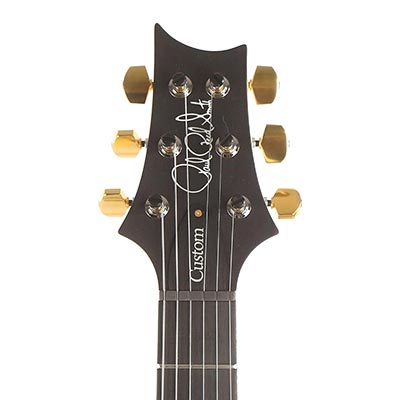
Paul Reed Smith Guitars are arguably the USA-made guitars today, and part of the reason why that is because they have opted to improve on pretty much everything that Gibson and Fender didn’t. PRS uses angled headstock, with a break angle of 10 to 11 degrees. One of the best things about the PRS is that they use the same headstock for all of their models, which allows for the same tuning stability and playability regardless of the money you have spent on their guitar. Also, their 3+3 layout of the tuners allow for the strings to leave the nut grooves at a perpendicular angle to the nut. PRS uses both one-piece and scarf joint headstocks for their guitars, with their cheaper instruments using the latter.
4. Ibanez
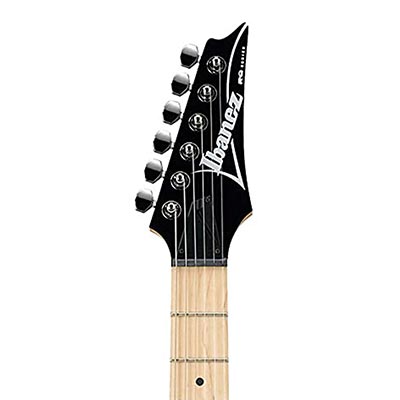
Ibanez is a quality brand known for its well-made guitars which feature really unique and aggressive designs featuring a lot of sharp angles and deep cutaways. The design of their headstocks is no exception. Their sharp-looking headstocks are also offset, which allows for a perpendicular angle between the nut and tuners, as in the case of PRS and Fender. Their mid-range and high-end models have an angled one-piece headstock, while their entry-level guitars may feature scarf joint headstocks. A lot of their guitars also feature volutes to make the neck/headstock connection stronger.
5. Schecter
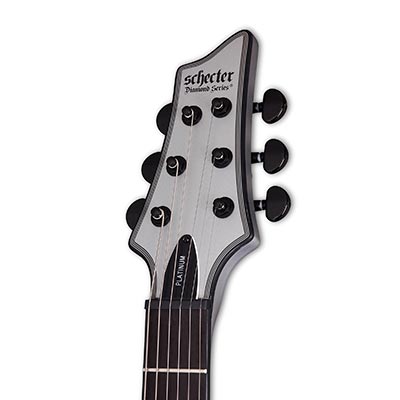
Schecter guitars are known for their quality and affordable price. They are ideal for heavier music genres, although their range is diverse enough so that anyone can find a guitar that suits their playing style. They stick with diversity when it comes to their headstocks as well. Sure, all of their guitars have an angled headstock, and most have volutes for added strength and rigidity, but their tuner layout is all over the place. You can find Schecters with a 6-in-line tuner layout, 2+4, which is basically a reversed 4+2 found on Music Man, as well as 3+3, which mimics the PRS. Most Schecters have a one-piece headstock.
6. Jackson
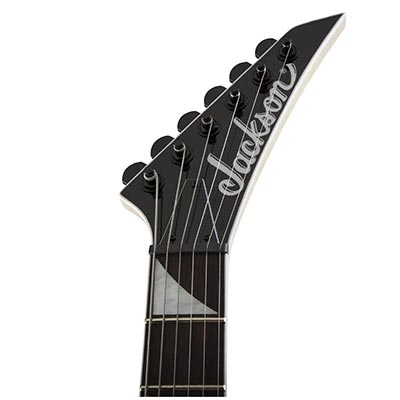
Like Schecter, Jackson guitars are popular among players of heavier musical genres and feature aggressive designs, not unlike those of Ibanez. When it comes to headstocks, they use scarf joints for the most part, which is probably the only possible option, considering the extreme design of their headstocks. In terms of tuner layout, there are Jackson with a 6-in-line tuner layout, as well as those with 3+3, but also 3+4 for their seven-string electric guitars.
7. Yamaha
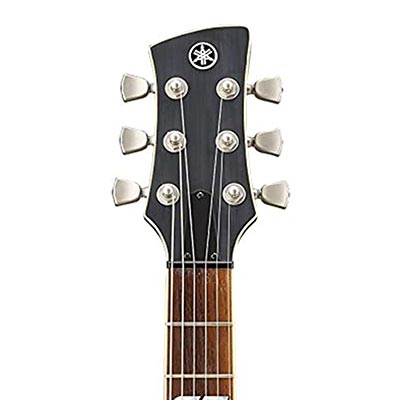
Yamaha has a really huge range, both acoustic and electric, so they don’t just opt for a single headstock design. It all depends on which series of Yamaha guitars we are talking about. For instance. Yamaha SGV series features angled headstocks. However, those from the Pacifica series, which mimic Fender Stratocaster, have flat headstocks, with a 6-in-line tuner layout. Similarly, their Les Paul-inspired guitars have angled headstocks with a 3+3 tuner layout.
8. Gretsch
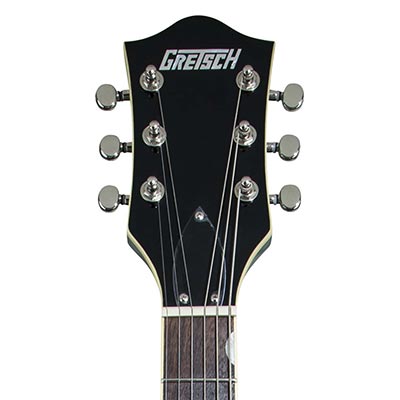
Gretsch guitars are some of the most beautiful instruments out there and offer great value. When it comes to their headstocks, they follow an approach that is similar to that of Gibson, which means having a one-piece angled headstock, with a 3+3 tuner layout. Gretsch guitar can often be seen with a volute, which makes the neck stronger.
9. Ernie Ball Music Man
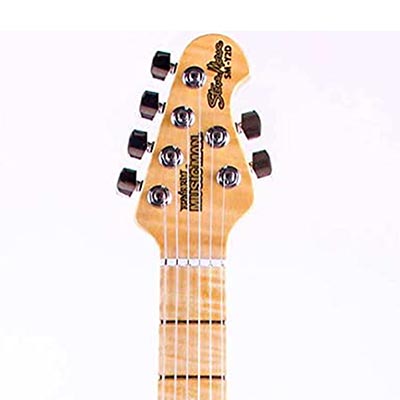
Music Man is among the most coveted and innovative guitar brands on the market, and one of the reasons for that is the fact that Leo Fender himself worked on the design of these instruments. That explains the flat headstock, which is standard on Fender guitars, as well as the perpendicular angle at which the string leaves the nut. To facilitate this, Music Man guitars use the 4+2 tuner layout for their headstocks.
10. Kiesel
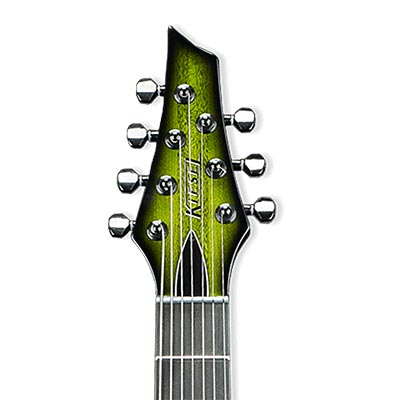
Because Kiesel has a very unusual business model, which involves them building a guitar specifically for you, you can pretty much get any kind of headstock design, whether it’s flat or angled. It all depends on the components that you choose. That is why you won’t find two Kiesel guitars that are alike. Their tuner layout is also all over the map, since Kiesel guitars can come with 6-in-line, 3+3, 4+2, or 2+4 string tuner layout, and in the case of their 7-string axes, 3+4 or 4+3 string tuner layout. They are true chameleons when it comes to headstock design.
And that’s pretty everything you need to know about headstock shapes and designs, as well as a few other things, such as break angle, tuners, truss rod, nuts, and string trees, among others, and how they all interact with each other. Although a headstock may not be a component most players look at when choosing a guitar for themselves, it has a major impact not just on the guitar’s tuning ability but also on playability and sound.
Popular Related Article: The Different Types of Guitar Strings Explained
What Does a Guitar Headstock Do?
Although a guitar headstock is made up of several different components, its most obvious function is to house the tuners, which are also referred to as tuning pegs, or machine heads. On most guitars, the strings are attached to the instrument at two different points: at the bridge, and the tuners. The latter not only keep the string connected and tight, but as their name indicates, they also have the task of keeping the strings in tune. Not a small feat, but a guitar headstock does a lot more, too. Once a guitar string is tightened, that puts a surprisingly large amount of force is exerted onto the tuners. If a headstock is not rigid and strong enough, this will result in a guitar going out of tune more often, which directly affects its sound and playability.
It’s pretty simple. The softer materials used to build the headstock, the weaker the sustain, created a muddy, muffled sound. On the other hand, if the headstock is made out of strong materials, the vibration of the strings will last longer, which results in a better sustain and clearer sound. Since we have mentioned that a headstock consists of a few different parts, let’s take a look at what they are:
Nut: This component is attached to the guitar between the headstock and the neck of the guitar, and is used to hold the strings in place so that they don’t slide from side to side too much. Of course, there is still enough room on the nut for every string to allow you to do bends. The nut is usually manufactured using really tough and dense materials, which makes sense, given how much friction and pressure it needs to withstand.
Also, denser materials do not dampen the vibration of the strings as much as the softer ones, which allows for clearer sound and longer sustain. Natural materials are the preferred choice here, and they include ebony, ivory, or bone. However, these can be very rare, expensive, or even illegal, which means that manufacturers need to look at synthetic substitutes which do not cause harm to endangered species. The most popular synthetic materials include Tusq, which is produced by Graphtec. Some brands, such as Gibson, use graphite or titanium. When it comes to budget guitars, the nut is usually made out of plastic.
A simple and cheap way to reduce the friction between the strings and the nut would be to apply some graphite, simply by tracing a pencil along the grooves of the nut.
Tuners: As we have mentioned before, the tuners keep the strings connected to the headstock and the pitch of each string in tune. They also enable you to change to adjust the guitar string for different tuning, not just the standard one. Different types of guitars will usually have different tuners. On classical guitar, for example, tuners are located on one or both sides of the headstock, with the gears exposed and housed in intricate braces, and usually feature plastic tuning knobs. Steel-stringed guitars have gears as well, but instead of being exposed, they are inside a metal housing, which adds a level of protection and prevents dust from collecting in there.
Truss rod: Although the majority of the truss rod is housed inside the neck of the guitar, it can be accessed through the headstock above the nut, in case of electric guitars, or from inside the soundhole, in the case of acoustic guitars. Tightening or loosening the truss rod allows you to adjust the tension of the guitar neck. In essence, the truss rod is a sturdy metal bar that runs along the entire length of the guitar neck. Using the truss rod, you can adjust the guitar action, which is the distance between the frets and the strings.
However, it also has a passive function, which is to make the neck stronger and stiffer, as well as to prevent it from getting damaged or broken due to environmental influences or damage. There are two types of truss rods. First, there is the single-action truss rod, which is designed to help you bend the neck backward to compensate for bending caused by the tension of the strings. Luthiers and manufacturers like it because it’s lighter and easier to build into the neck. However, it is more prone to atmospheric changes.
Second, there is the dual-action truss rod, which allows you to bend the neck either way. While it is heavier, it also makes the neck stronger, although not impervious to external influences and conditions. With this type of truss rod, you can both raise and lower the action of the string. Lowering the strings allows you to play fast and more comfortably, while raising them makes for a clearer sound, but requires you to use more force when fretting.
Headstock head: Although most headstock heads are used to do the same thing, which is to house all of the parts described above, they are different from one another when it comes to looks since every guitar manufacturer uses the headstock to establish a unique visual identity for each guitar model they produce. Some headstocks, like those found on the Strat or a Les Paul, are nothing short of iconic, while others, like those mounted to Seagull acoustic guitars, also play a role when it comes to tonal qualities of the instrument.
Tonewoods are not just used for the body and the neck of the guitar, but for the headstock head, as well. Since each tonewood has its unique grain, density, and tonal properties, its choice will affect the sound, giving it less or more sustain. Headstock heads are always made out of the same tonewood as the neck. In most cases, dense tonewoods such as maple, rosewood, or mahogany are used.
What Is the Optimal Angle of the Headstock?
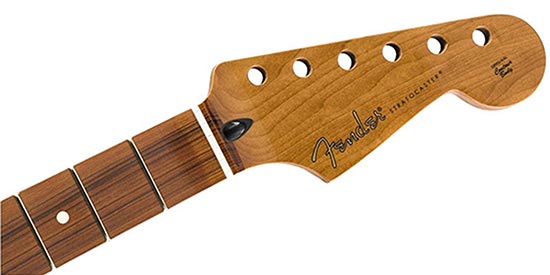
It’s hard to come up with a straight answer on this one, because there are so many different opinions, although most people wouldn’t even notice the difference. Gibson has led the way for angled headstocks, and they have opted for a 17-degree angle, but over time, they have changed it to 14 degrees. It’s hard to say whether they have done that because their headstocks were breaking, or because it made a significant difference when it came to production costs or even tone. And the angles are all over the place as far as other manufacturers are concerned, so you will come across 10, 12, and 13-degree angles.
The only thing that most experts agree on is that the angle matters the most when it comes to strings not slipping from their grooves in the nut when bent. But even then, it’s the angle of the string that is crucial and not the angle of the headstock. As we have explained before, some manufacturers, such as Fender, have achieved optimal angles by using string trees on the fourth and fifth strings, as well as by implementing staggered tuners on their premium models.
Does Sideways Angle of the Strings Matter?
So far, we have talked about the break angle of the strings, which you can view by looking at the headstock and the neck of the guitar sideways. But, if you were to face the headstock, you would be able to see that the strings on some guitars enter or leave the nut at an angle before they reach the tuning pegs. Some brands, such as Gibson, Jackson, Rickenbacker, or Gretsch, have let the shape of their headstock dictate the layout of their tuning pegs, and therefore the sideways angle of the strings. Others, such as Fender, PRS, and the Music Man, all have strings that run perpendicular to the nut before they reach the tuning pegs. Does this angle matter at all?
Well, the larger the sideways angle, the bigger the pressure on the string. While this might not affect the tone of the guitar, it may affect its playability, especially when doing huge bends or using a tremolo, as well as its ability to stay in tune. This issue is particularly common on Gibson guitars, whose strings can stick inside the nut. However, they have been working on a solution by employing self-lubricating nuts made of graphite or titanium alloy nuts.
Another factor that might not be as crucial as the angle of strings, but which still influences playability, is the distance between the tuning pegs and the nut that the strings need to cover. Fender Stratocaster, for example, has six-in-line tuners, which often require the use of string trees to put pressure on the string and keep them within their lanes. Of course, the most obvious solution would be to keep the distance between the tuners and the nut as short as possible, which has enabled guitar manufacturers to come with some creative designs and layouts. PRS has opted for a 3+3 layout, and since they use pretty much the same headstock design across their entire range, they can utilize the same tuner layout.
Music Man used the 4+2 layout, but what it has in common with the PRS is the headstock shape, which is tapered, but the same can be achieved with a triangular or trapezoid design. Brands like Schecter, Kiesel, Jackon, and ESP use similar shapes for their headstock, and even Gibson does it in the case of the Flying V. The advantage of PRS’s and Music Man’s use of the same headstock for nearly all of their guitars is the consistent tuning ability regardless of the model. If you are touring musicians and play live a lot, it makes sense to choose a guitar that will stay in tune for as long as possible, which is why modern headstocks which use the 3+3 or 4+2 layout might be a better option.
Popular Related Article: Types of Acoustic Guitars Explained
Headstock Looks Do Matter
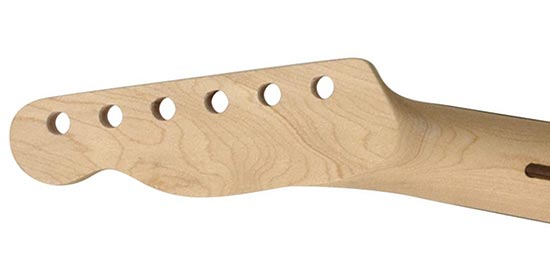
You would be surprised how much effort guitar manufacturers put into the design of their headstocks, and we are not talking about the angles here, but purely about the aesthetics. Brands that have iconic guitars, such as Gibson and Fender, are instantly recognizable, which means they are pretty much set in their tracks in terms of design, and they can only make small tweaks and improvements. Otherwise, their followers would go crazy. Other manufacturers have more options at their disposal. They can either copy or use famous headstocks as inspiration, or they can simply come up with entirely new designs, or improve upon the flaws of existing ones.
Also, headstocks are used by manufacturers to showcase the level of their attention to detail and craftsmanship. Some headstocks will simply have a natural finish, while others will feature a brand’s logo, while those found on premium models will come with a veneer cover, binding, or even inlays. Obviously, all of this has to do with looks and prestige, and absolutely nothing with sound. However, there has been some contention among brands when it comes to the looks of their headstock, and a couple of years ago, some brands, like Gibson, have gone as far as to sue other guitar manufacturers, because they have either copied their design or borrowed heavily from them.
Gibson vs. Dean Lawsuit
Back in 2019, Gibson sued Armadillo, which is a company that owns Dean and Luna Guitars, for copyright infringement, claiming that Dean has copied several of Gibson’s guitar body shapes, including the Flying V, the Explorer, and the ES-335, as well as the ‘Dove Wing’ headstock design. Although it has been proven in the past that it’s almost impossible to copyright a guitar shape, Gibson and Dean are still going to court.
And that’s pretty everything you need to know about headstock shapes and designs, as well as a few other things, such as break angle, tuners, truss rod, nuts, and string trees, among others, and how they all interact with each other. Although a headstock may not be a component most players look at when choosing a guitar for themselves, it has a major impact not just on the guitar’s tuning ability but also on playability and sound.
This may seem like a lot of information to take in, given the fact that you need to consider so many other guitar components and specs, but know your playing style or the genre of music you prefer, but knowing more about the guitar headstock can actually help you narrow down your choice of the guitar. We hope that you will have found this article helpful, and feel free to check out our other in-depth guitar-related guides. Good luck!
Wrap up:
As we have pointed out in our previous articles, picking the right guitar for yourself is easier said than done, because there are so many different factors and parameters that you need to take into account. Once you start getting into the nuts and bolts of it all and making the most of what the guitar has to offer. We hope this article was informative. Let us know if you have any questions or comments below.

My name is Chris and I’ve had a passion for music and guitars for as long as I can remember. I started this website with some of my friends who are musicians, music teachers, gear heads, and music enthusiasts so we could provide high-quality guitar and music-related content.
I’ve been playing guitar since I was 13 years old and am an avid collector. Amps, pedals, guitars, bass, drums, microphones, studio, and recording gear, I love it all.
I was born and raised in Western Pennsylvania. My background is in Electrical Engineering, earning a Bachelor’s degree from Youngstown State University. With my engineering experience, I’ve developed as a designer of guitar amplifiers and effects. A true passion of mine, I’ve designed, built, and repaired a wide range of guitar amps and electronics. Here at the Guitar Lobby, our aim is to share our passion for Music and gear with the rest of the music community.

X
Changed my life, for real, such detailed and professional about what I just needed. Thank you so much!
Thank you Mr. Schiebel, for this excellent article!
I believe you wrote a review of the 10 best multmeters for 2022. I Thank you for that excellent article as well.
Please keep them coming.
Do you have a listing of your work? I’d be interested in reading all of it and recommending it to my friends.
Regards